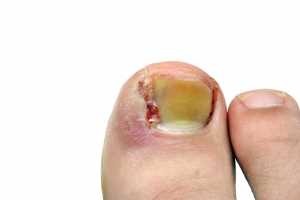There is an old quote I often use about gout: put your finger in the vice grip and tighten it as hard as you can, that is rheumatism; give it another half turn, that is gout. The message of the quote is that gout really hurts, it is really painful, exquisitely painful. That is the hallmark of gout. Gout most frequently affects the big toe joint of the foot and if you only have minor pain, then its probably not gout.
A red, hot, inflamed, swollen big toe joint is probably gout. However, it could be due to other things as well. The most important of those is an infection in the joint, which is really serious as it needs to be diagnosed and treated urgently to prevent any destruction in the joint from the infection and the inflammation and to prevent the infection spreading.
Gout occurs when uric acids crystals deposit inside the joint because it is the body’s way of getting rid of the higher levels in the blood. It does not work out too well and that uric acid causes the painful inflammatory reaction in the joint. The uric acid comes from purines, so the best way to treat gout over the longer term is to reduce the dietary intake of food that are higher in that (eg alcoholic beverages; some fish, seafood and shellfish, including anchovies, sardines, herring, mussels, codfish, scallops, trout and haddock; some meats, such as bacon, turkey, veal, venison and organ meats like liver) or use drugs that help the body to get rid of the purines (drugs to block uric acid production such as allopurinol and febuxostat or drugs that improve uric acid removal by the kidney such as probenecid and lesinurad).
Other drugs such as colchicine and anti-inflammatory drugs are also used, more in the short term to help with the pain. ICE packs over the joint too can also help.
Gout is not really a condition of overindulgence or lifestyle as is portrayed in the stereotypes, it is mostly a condition of genetics with lifestyle and diet only playing a smaller, but still important part. This historical perception of gout is a barrier to proper care and management. Those with gout have been shown to have a poor adherence to the correct medication routine and this is hampering the management, so please follow the medical advice for the treatment.





